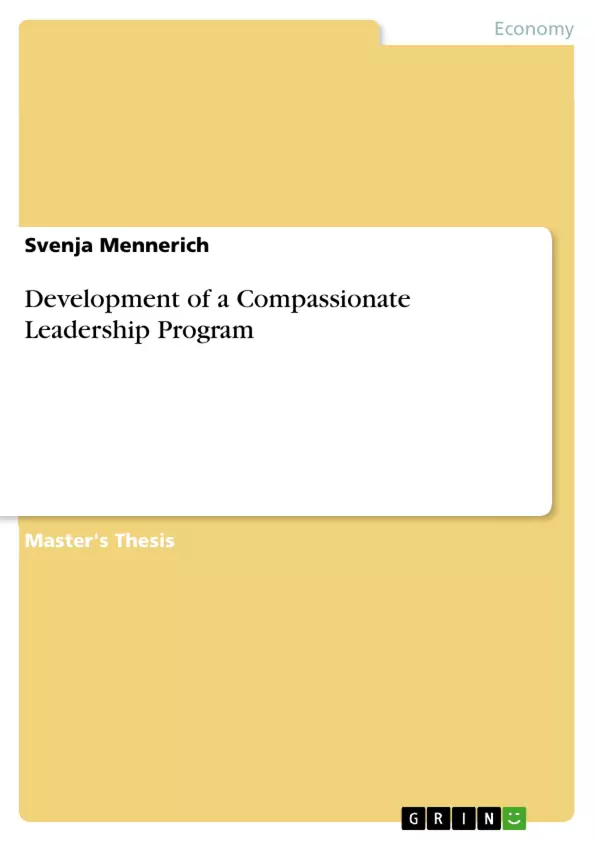
Development of a Compassionate Leadership Program
Masterarbeit, 2023
77 Seiten, Note: 1,0
Leseprobe
Inhaltsverzeichnis (Table of Contents)
- 1. INTRODUCTION
- 2. THEORY
- 2.1 COMPASSIONATE LEADERSHIP
- 2.1.1 Definition of compassionate leadership
- 2.1.2 Dimensions of compassionate leadership
- 2.1.3 Current state of research on compassionate leadership
- 2.1.4 Demarcation to other leadership styles
- 2.2 TRAINING TRANSFER
- 2.2.1 Definition of training transfer
- 2.2.2 What makes trainings effective?
- 2.3 LEADERSHIP COACHING
- 2.3.1 Definition of leadership coaching
- 2.3.2 Elements of leadership coaching
- 2.3.3 The GROW coaching model
- 2.3.4 Demarcation to other leadership coaching styles
- 2.1 COMPASSIONATE LEADERSHIP
- 3. CONCEPTUAL DEVELOPMENT OF THE COMPASSIONATE LEADERSHIP PROGRAM
- 3.1 TRAINEE CHARACTERISTICS
- 3.2 NEED ANALYSIS
- 3.3 DEVELOPMENT COMPASSIONATE LEADERSHIP TRAINING
- 3.3.1 Pre- and post-survey
- 3.3.2 Factors of training design
- 3.3.3 Training framework
- 3.4 DEVELOPMENT COACHING SESSION
- 3.5 DEVELOPMENT SELF-REFLECTION JOURNAL
- 4. PILOTING OF THE COMPASSIONATE LEADERSHIP PROGRAM
- 4.1 PREPARATION OF THE PILOTING
- 4.1.1 Description of the company and target group
- 4.1.2 Leadership development programs within the company
- 4.1.3 Business problem and implications
- 4.2 EXECUTION OF THE PILOTING
- 4.2.1 Piloting of the compassionate leadership training
- 4.2.2 Piloting of the GROW Coaching Sessions
- 4.1 PREPARATION OF THE PILOTING
- 5. RESULTS
- 6. DISCUSSION
- 6.1 INTERPRETATIONS AND IMPLICATIONS
- 6.2 LIMITATION OF THE STUDY
- 6.3 RECOMMENDATIONS
Zielsetzung und Themenschwerpunkte (Objectives and Key Themes)
This study aims to develop and evaluate a compassionate leadership program designed to alleviate workplace stress. It bridges the gap in research on implementing such programs within corporate settings by proposing a two-phased approach combining group training and individual coaching. The effectiveness of this approach in enhancing knowledge and perceived training transfer is evaluated through pre- and post-training surveys.
- Development of a compassionate leadership program for corporate settings.
- Evaluation of the effectiveness of a combined training and coaching approach.
- Assessment of knowledge enhancement and training transfer.
- Exploration of the impact of compassionate leadership on workplace stress.
- Contribution to more people-centered workplaces.
Zusammenfassung der Kapitel (Chapter Summaries)
1. INTRODUCTION: This introductory chapter sets the stage for the study by highlighting the increasing demand for leadership development due to factors such as the COVID-19 pandemic, political instability, and rapid technological advancements. It emphasizes the need for innovative approaches to leadership, particularly those that address high stress levels among employees. The chapter introduces compassionate leadership as a potential solution and identifies a gap in research concerning the development and implementation of compassionate leadership programs in corporate environments. The study's objective to address this gap by presenting a two-phased program combining training and coaching is clearly stated.
2. THEORY: This chapter lays the theoretical groundwork for the study by defining and exploring the key concepts of compassionate leadership, training transfer, and leadership coaching. It delves into the definition, dimensions, and current research on compassionate leadership, differentiating it from other leadership styles. The chapter also examines training transfer, focusing on factors that contribute to effective training and its application in the workplace. Finally, it defines and describes leadership coaching, highlighting the GROW model and distinguishing it from other coaching approaches. These theoretical underpinnings provide a robust framework for the program's development and evaluation.
3. CONCEPTUAL DEVELOPMENT OF THE COMPASSIONATE LEADERSHIP PROGRAM: This chapter details the design and development of the compassionate leadership program. It outlines the characteristics of the target trainee group and presents a comprehensive need analysis. A detailed description of the program's training component, including the structure, content, and methods used, is provided, along with an explanation of the pre- and post-survey instruments. The chapter also describes the individual coaching sessions, utilizing the GROW model, and the development of a self-reflection journal to aid in learning and application. The design choices are meticulously explained, emphasizing the program's efficiency and practicality.
4. PILOTING OF THE COMPASSIONATE LEADERSHIP PROGRAM: This chapter describes the implementation of the compassionate leadership program in a real-world setting. It begins by detailing the preparation phase, including the description of the participating company, target group, and the existing leadership development programs within the organization. The chapter also addresses the specific business problem and its implications, further justifying the choice of this intervention. It then provides a detailed account of the piloting process, encompassing both the training sessions and the individual coaching sessions. The methodology used in each phase is precisely described, adding to the study's rigor and reproducibility.
5. RESULTS: This chapter presents the quantitative and qualitative findings from the study's data analysis. It will likely showcase the results of the pre- and post-training surveys, quantifying the change in participants' understanding of compassionate leadership and their perceived application of the learned skills in the workplace. The chapter might also present feedback from participants and observations from the coaching sessions. This detailed account of the research findings will be crucial for understanding the program's effectiveness.
6. DISCUSSION: This chapter will delve into the interpretation and implications of the findings presented in Chapter 5. The researchers will analyze the results, discussing the strengths and limitations of the study, and offering recommendations for future research and program improvements. The discussion should also place the findings within the broader context of existing literature on compassionate leadership, training transfer, and leadership coaching, highlighting any contributions made by the study.
Schlüsselwörter (Keywords)
Compassionate leadership, leadership development, training transfer, leadership coaching, GROW model, workplace stress, employee well-being, program evaluation, organizational development, self-reflection.
Frequently Asked Questions: Compassionate Leadership Program Development and Evaluation
What is the main focus of this study?
This study focuses on developing and evaluating a compassionate leadership program designed to alleviate workplace stress. It uses a two-phased approach combining group training and individual coaching.
What are the key themes explored in the study?
The key themes include compassionate leadership, training transfer, leadership coaching (specifically the GROW model), workplace stress, and the effectiveness of a combined training and coaching approach for leadership development.
What is the structure of the compassionate leadership program?
The program is a two-phased approach. The first phase involves group training focusing on compassionate leadership principles. The second phase consists of individual coaching sessions utilizing the GROW model, complemented by a self-reflection journal for trainees.
What methods were used to evaluate the program's effectiveness?
Pre- and post-training surveys were used to assess knowledge enhancement and perceived training transfer. Qualitative data, including feedback from participants and observations from coaching sessions, likely contribute to the overall evaluation.
What theoretical frameworks underpin the study?
The study draws upon theories of compassionate leadership, training transfer, and leadership coaching. It defines these concepts, explores their dimensions, and relates them to the program’s design and evaluation.
Who were the participants in the study?
The study involved a specific company and its employees as a target group. Details about the company and its existing leadership development programs are provided in the study.
What are the key findings of the study?
The detailed results of the quantitative and qualitative data analysis (pre- and post-training surveys, participant feedback, coaching observations) are presented in a dedicated chapter. These findings quantify the changes in participants' understanding and application of compassionate leadership principles.
What are the limitations of the study?
The study acknowledges and discusses its limitations, which are important for interpreting the findings and understanding their generalizability.
What are the recommendations for future research and program improvement?
The study concludes with recommendations for future research to further explore the impact of compassionate leadership and refine the program's design based on the findings.
What are the keywords associated with this study?
Compassionate leadership, leadership development, training transfer, leadership coaching, GROW model, workplace stress, employee well-being, program evaluation, organizational development, and self-reflection.
What is the overall goal of the compassionate leadership program?
The overall goal is to alleviate workplace stress by enhancing leadership skills through a comprehensive program focused on compassionate leadership principles.
How does the study contribute to existing knowledge?
The study addresses a gap in research by proposing and evaluating a practical two-phased compassionate leadership program in a corporate setting. It contributes to understanding the effectiveness of combining training and coaching for leadership development and its impact on employee well-being.
Details
- Titel
- Development of a Compassionate Leadership Program
- Hochschule
- Deutsche Hochschule für Gesundheit und Sport (vormals H:G Hochschule für Gesundheit & Sport, Technik & Kunst)
- Note
- 1,0
- Autor
- Svenja Mennerich (Autor:in)
- Erscheinungsjahr
- 2023
- Seiten
- 77
- Katalognummer
- V1449461
- ISBN (Buch)
- 9783963559938
- Sprache
- Englisch
- Schlagworte
- Konzeptarbeit Compassionate Leadership Coaching
- Produktsicherheit
- GRIN Publishing GmbH
- Preis (Ebook)
- US$ 31,99
- Preis (Book)
- US$ 44,99
- Arbeit zitieren
- Svenja Mennerich (Autor:in), 2023, Development of a Compassionate Leadership Program, München, Page::Imprint:: GRINVerlagOHG, https://www.diplomarbeiten24.de/document/1449461
- Autor werden
- Ihre Optionen
- Vertriebskanäle
- Premium Services
- Autorenprofil
- Textarten und Formate
- Services für Verlage, Hochschulen, Unternehmen

- © GRIN Publishing GmbH.
- Alle Inhalte urheberrechtlich geschützt. Kopieren und verbreiten untersagt.
- info@grin.com
- AGB
- Open Publishing
Der GRIN Verlag hat sich seit 1998 auf die Veröffentlichung akademischer eBooks und Bücher spezialisiert. Der GRIN Verlag steht damit als erstes Unternehmen für User Generated Quality Content. Die Verlagsseiten GRIN.com, Hausarbeiten.de und Diplomarbeiten24 bieten für Hochschullehrer, Absolventen und Studenten die ideale Plattform, wissenschaftliche Texte wie Hausarbeiten, Referate, Bachelorarbeiten, Masterarbeiten, Diplomarbeiten, Dissertationen und wissenschaftliche Aufsätze einem breiten Publikum zu präsentieren.
Kostenfreie Veröffentlichung: Hausarbeit, Bachelorarbeit, Diplomarbeit, Dissertation, Masterarbeit, Interpretation oder Referat jetzt veröffentlichen!
- GRIN Verlag GmbH
-
- Nymphenburger Str. 86
- 80636
- Munich, Deutschland
- +49 89-550559-0
- +49 89-550559-10
- info@grin.com
-









